七下英语Unit2教案新部编本
七年级下册unit2 教学设计新部编版

__ After that, I always brush my teeth and go to school at eight.
__ Then I quickly have a shower and eat breakfast.
__ I have lunch at a quarter to twelve.
课时
安排
共五课时
主备教师
方源
第五课时
授课人
Knowledge aims
1. Words & expressions
2. Key sentences:What time does he get up?
Ability aims
1. Ss learn to use First…then…next…after that…to write their daily routines. 2. Review of the important items in this unit.
教师学科教案
[20 – 20学年度第__学期]
任教学科:_____________
任教年级:_____________
任教老师:_____________
xx市实验学校
七年级下册unit2SectionB ---Self-check英语教学设计
Teaching content
Unit2What time do you go to school?SectionB---Self-check)
5.The teacher say something about himself.
Ⅲ.Self Check
1.All the Ss read the wordsin part 1,Make phrases with the words in the boxes..
英语七年级下UNIT2教案

英语七年级下UNIT2教案英语七年级下UNIT2教案课题名称: Unit 2 Why do you like koalas ? 〔第一课时〕教材选自:《新目的英语》第二册 (Go for it ! Book 2)一、简介本次任务型活动课的主题为:Why do you like koala bears ?关键信息:任务型学习的教学形式(Task-based Language Learning)是《英语课程标准》倡导的教学形式。
其目的是让学生在老师的指导下,通过感知、体验、理论、参与和合作等方式实现任务,感受成功的心理体验。
学生通过考虑、讨论和交流,学习和使用英语,从而完成学习任务。
二、学生分析^p本次活动课合适初一年级的学生〔即13-14岁年龄段的〕。
要求具备一定的根本知识和技能,对英语学习有持续的兴趣和爱好,能用简单的英语问候、打招呼,交换有关个人、家庭、朋友等的根本信息,在图片的帮助下听懂、读懂并讲述简单的故事,根据图片或提示写出简单的句子,根据所学内容表演小对话,在课堂活动中乐于模拟、敢于开口,积极参与,主动请教。
对即将学习的内容能适当地提早做好预习工作。
三、教材分析^p本教材分为A、B两局部,A局部是根本的语言内容,包括本单元的重点词汇、任务型听力练习、对话练习及语法重点(Grammar Focus);B局部是知识的扩展和综合的语言运用,包括词汇扩展、语言知识综合运用及各类阅读文章,并附有自测(Self Check)局部,用来自我检测本单元所学的知识,最后还有让学生轻松一刻的卡通幽默 (Just for fun)。
四、教学设计核心任务:根据学生的年龄特点和认知才能,从学生的学习兴趣、生活经历和认知程度出发,倡导体验、理论、参与、合作与交流的学习方式和任务型的教学途径,开展学生的综合语言运用才能,使语言学习的过程成为学生形成积极的情感态度、主动思维和大胆理论和形成自主学习才能的过程。
教学目的:2、用英语议论、描绘动物(describe animals)并表达对动物各自的喜欢(express preferences),例如:Tigers are kind of scary。
七年级英语下册《Unit 2 》教案
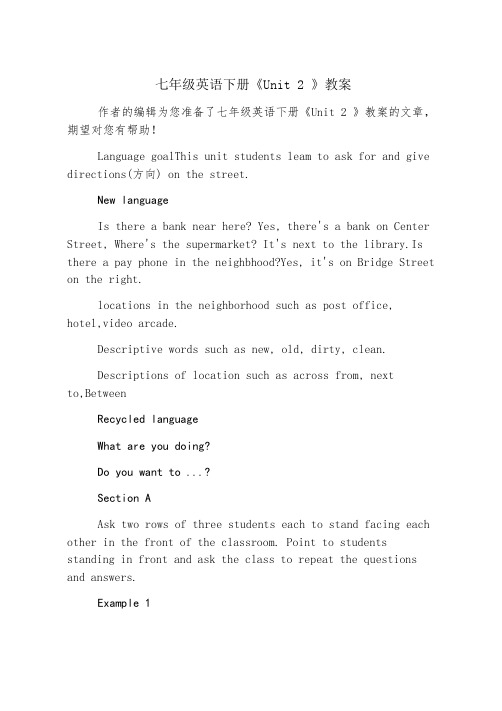
七年级英语下册《Unit 2 》教案作者的编辑为您准备了七年级英语下册《Unit 2 》教案的文章,期望对您有帮助!Language goalThis unit students leam to ask for and give directions(方向) on the street.New languageIs there a bank near here? Yes, there's a bank on Center Street, Where's the supermarket? It's next to the library.Is there a pay phone in the neighbhood?Yes, it's on Bridge Street on the right.locations in the neighborhood such as post office, hotel,video arcade.Descriptive words such as new, old, dirty, clean.Descriptions of location such as across from, nextto,BetweenRecycled languageWhat are you doing?Do you want to ...?Section AAsk two rows of three students each to stand facing each other in the front of the classroom. Point to students standing in front and ask the class to repeat the questions and answers.Example 1Teacher: Where'sYang Li? (Point to two students standing beside each other.) Yang Li is next to Li .Example 2Teacher: Where's Zheng Wen? (Point to two students in different lines facing each other.)Zheng Wen is across from Sheng Lin.Example 3Teacher: Where's Lin Jiahui? (Point to one student standing between two other students.) Lin Jiahui is between Sheng Lin and Li Dai.la This activity introduces the key vocabulary.Focus attention on the picture. Ask students to name as many of the places they see in the picture as they can.Then name all the places and ask students to repeat.Point out the numbered list of words. Say each one and ask students to repeat.Then ask students to match each word or phrase on thelist with one of the pictures. Say, Write the letter of each place in the picture next to the correct word or words on the list. Point out the sample answer f.Check the answers.1b This activity gives students practice listening to and understanding the target language.Point out the buildings and other locations in the picture. Say the name of each one to the class.Say, Now I will play recordings of three conversations. Listen carefully and circle the picture of each place you hear on the tape..Play the recording the first time. Students only listen.Play the recording a second time. This tine ask students to listen and circle the items they hear on the picture.Correct the answers.These items should be circle:video arcade, post office, supermarket.Tapescript(录音稿)Convernation 1A: Is there a video arcade on Fifth Avenue?B: Yes, there is.Conversation 2A: Is there a post office near here?B: Yes, there is. There's one on Bridge Street.Conversation 3A: Is there a supermarket on Center Street?B: No, there isn't.1C This activity provides guided oral practice using the target language.Point to the different locations shown in the picture.Ask different students to name each one. If necessary,say the name and ask the student to repeat.Point to the question and answer In the example conversation and ask a pair of students to read theconversation to the class. Ask other pairs of students torepeat the activity if you wish.Ask students to work in pairs. Say, First one person asks a question and then the other person takes a turn.Demonstrate(示范) the activity. Point to the picture and ask. Is there a post office near here? Then choose a studentto answer. Guide the student to say, Yes,there's a post office on Bridge Street.As students work, move around the room and checkprogress(进展情形). Help students understand how to locate things on the map, if necessary.Ask several students to say some of their questions and answers for the class.教学后记:教学方法有问题?教了这么多年的英语,总空想有一种方法,能让学生轻轻松松把英语学好。
七年级下册英语unit2教案

七年级下册英语unit2教案英语教案作为反映英语教师知识组织形式、教学行为方式差异的具体表征,是教师职业能力发展的重要体现。
下面是小编为大家精心整理的七年级下册英语unit2教案,仅供参考。
七年级下册英语unit2教案范文Unit 2 What time do you go to school?Section A (1a-2d)一、教学目标:1. 语言知识目标:1) 能掌握以下单词:up, get up, dress, get dressed, brush, tooth (pl. teeth) brush teeth, shower, take a shower, usually, forty, fifty, wow, never, early, job, work, station, radio station, o'clock, funny, exercise 能掌握以下句型:① —What time do you usually get up? —I usually get up at six thirty.② —When do you go to work? —I usually go to work at eleven o'clock. ③ —He has an interesting job. —He works at a radio station.2) 用when和what time引导的特殊疑问句询问时间和时间的表达法;用所学的目标语言对生活和学习活动做计划,学会合理地安排作息时间。
2. 情感态度价值观目标:本部分的话题是“日常作息时间”,学习内容贴近学生的生活,因为学生的作息时间安排是非常有规律的。
通过互相询问或谈论自己或对方的作息时间安排和活动计划,可以培养学生良好的作息习惯和守时习惯。
二、教学重难点1. 教学重点:1) 掌握时间的简单表达方式。
2) 学习询问和谈论时间和制订作息时间表。
教师备课——英语七年级下UNIT2教案2
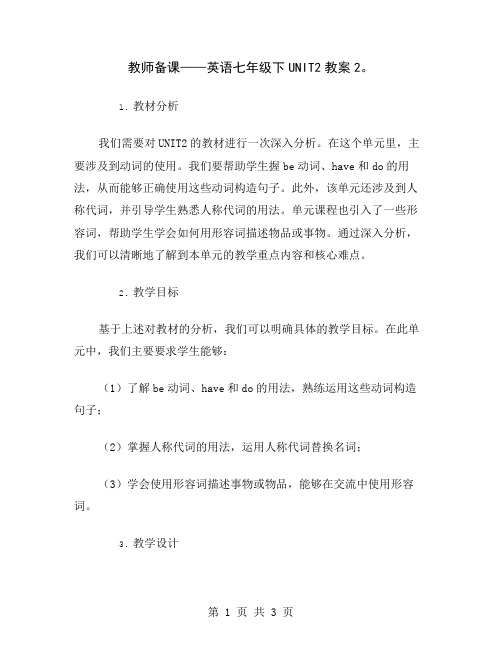
教师备课——英语七年级下UNIT2教案2。
1.教材分析我们需要对UNIT2的教材进行一次深入分析。
在这个单元里,主要涉及到动词的使用。
我们要帮助学生握be动词、have和do的用法,从而能够正确使用这些动词构造句子。
此外,该单元还涉及到人称代词,并引导学生熟悉人称代词的用法。
单元课程也引入了一些形容词,帮助学生学会如何用形容词描述物品或事物。
通过深入分析,我们可以清晰地了解到本单元的教学重点内容和核心难点。
2.教学目标基于上述对教材的分析,我们可以明确具体的教学目标。
在此单元中,我们主要要求学生能够:(1)了解be动词、have和do的用法,熟练运用这些动词构造句子;(2)掌握人称代词的用法,运用人称代词替换名词;(3)学会使用形容词描述事物或物品,能够在交流中使用形容词。
3.教学设计基于教材分析和教学目标,我们需要进行详细的教学设计。
我们可以通过提供一些生动的语言材料,向学生展示be动词、have和do 的用法。
在这个过程中,可以帮助学生发现一些常见的语言规律和用法,如肯定句、否定句和疑问句等。
同时,也可以通过练习帮助学生熟悉这些动词的使用方法。
我们可以引导学生熟悉人称代词的使用。
通过对语言材料的分析和练习,学生可以逐渐理解代词在句子中的作用和用法,并掌握有效地使用人称代词进行交际的技能。
我们可以引入形容词,让学生重点了解形容词与名词搭配方法,并且在生活实践中加强彼此搭配的印象。
在此过程中,教师要注意语言的生动性和趣味性,让学生更好地理解用法,同时,鼓励他们在交流中积极运用词汇。
4.教学评估在教学过程中,我们需要对学生的掌握情况进行评估。
在这个过程中,我们可以使用各种形式的评估方法,如听力、口语、阅读和写作等,以帮助学生全面地巩固并使用教材中的词汇和语法。
5.课后回顾最后要注意的是,教师在教学结束后,应该对教学过程进行总结和回顾,以保证学生可以更好地理解和掌握所学的内容。
在回顾过程中,可以和学生讨论一些重点难点,从而加深对其的印象,巩固所学的知识。
教案新部编本—《Unit 2 my family》

教师学科教案[ 20 – 20 学年度第__学期]任教学科:_____________任教年级:_____________任教老师:_____________xx市实验学校教案—《Unit 2 my family》Unit 2 my familyLesson oneTeaching aims:1. Knowledge aims:a. Learn the sentences: who’s that man(boy)? He’s my…who’s tha t woman(girl)? She’s my ….b. Learn the sentences: This is ……He /She is.......2. The target of skills:a. Master the words and sentences.b. Can introduce one’s family using the words and sentences learned in this lesson.3. The target of emotion:To inspire the students' interest of learning English and love their family.Teaching main difficult points:Main points: the new words and sentences.Difficult points:The pronunciation of the new words,talking about the family.Teaching aids:Prepare some family members cards,family photosTeaching procedure:1.Warm-up:a.Greetings :T:Good morning, boys and girls!S:Good morning, Miss Yang.T:How are you?S:Fine,thank you.T:I’m from china.Where are you from?S:I’m from ….T:Nice to meet you.S:Nice to meet you ,too.b.Let’s do:A A A,Say “OK”.2. Presentation(1). To review the words of father and motherShow the word cards: father,Mother,man,woman.(2)Show the picture of Chenjie.T:Look! Who’s that girl? Do you know? Oh,She’s Chenjie.She’s my friend.Now,Read after me.“She’s Chenjie.She’s my friend”Write “she’s”on the biackbord.(3)Show the picture of Mike.T:Look! Who’s that boy?Can you know? Oh,He’s Mike.He’s my friend.Now,Read after me.“He’s Mike.He’s my friend”Write “He’s”on the b iackbord.(4)Point to all the class ask: who’s that boy? He’s …who’s that girl? She’s ….(5)Show the picture of teacher.T: Who’s that woman? Who’s that man?S: She’s Miss….He’s Mr….(6)Show the photo of family.T: This is my family .she is my mother.He’s my father.(repeat words mom and dad)Now open your book,turn to page 14.look at these sentences.poin to the sentences.Listen talk,read talk.3.practice:(1) Who’s family is this?Show the student’s photo ask: Who’s family is this?S:This is my family.T:Can you introduce your family?S:Sure. This is my family. she’s my mother. He’s my mother.(Go on, students between students ask and answer.)(2)Magic ears.First, student close his eyes,another student say English .First student guess: He’s…./She’s….(3)sing and songDo you love your family? All right,Let’s sing《father and mother》.T:Class 3 grad 3 is a big family,We are all the members of this family,Please love eatch other and help eatch other.Extensiona.listen and read talk.b. Can intro duce one’s family using the words and sentences learned in this lesson.Blackboad—writing designUnit 2 My familyPart A Let’s talkWho’s that woman?She’s ….Who’s that man?He’s….。
七年级下册英语unit2教案
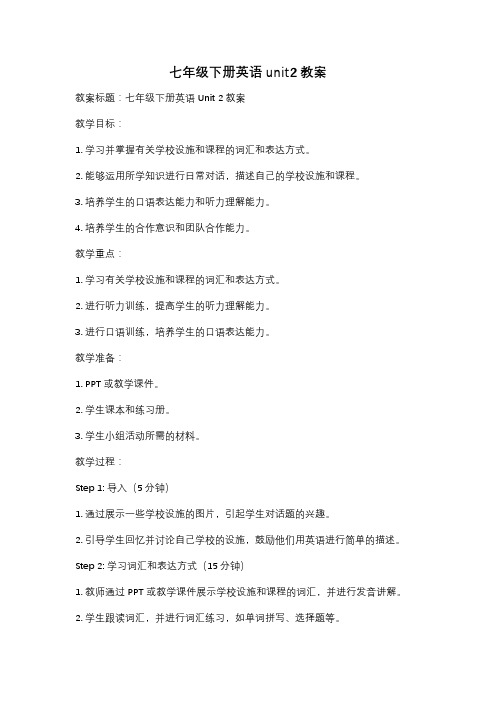
七年级下册英语unit2教案教案标题:七年级下册英语Unit 2教案教学目标:1. 学习并掌握有关学校设施和课程的词汇和表达方式。
2. 能够运用所学知识进行日常对话,描述自己的学校设施和课程。
3. 培养学生的口语表达能力和听力理解能力。
4. 培养学生的合作意识和团队合作能力。
教学重点:1. 学习有关学校设施和课程的词汇和表达方式。
2. 进行听力训练,提高学生的听力理解能力。
3. 进行口语训练,培养学生的口语表达能力。
教学准备:1. PPT或教学课件。
2. 学生课本和练习册。
3. 学生小组活动所需的材料。
教学过程:Step 1: 导入(5分钟)1. 通过展示一些学校设施的图片,引起学生对话题的兴趣。
2. 引导学生回忆并讨论自己学校的设施,鼓励他们用英语进行简单的描述。
Step 2: 学习词汇和表达方式(15分钟)1. 教师通过PPT或教学课件展示学校设施和课程的词汇,并进行发音讲解。
2. 学生跟读词汇,并进行词汇练习,如单词拼写、选择题等。
3. 学生进行词汇对话练习,操练如"How many classrooms are there in your school?"等句型。
Step 3: 听力训练(15分钟)1. 教师播放录音,学生听录音并回答相关问题。
2. 学生进行听力练习,如填空、选择题等。
Step 4: 口语训练(20分钟)1. 学生分组进行小组活动,讨论并描述自己学校的设施和课程。
2. 学生展示他们的讨论成果,分享自己的观点和意见。
3. 教师进行点评和指导,帮助学生改进口语表达。
Step 5: 练习册活动(10分钟)1. 学生完成练习册上与本单元内容相关的练习题。
2. 教师检查学生的练习册,给予必要的指导和反馈。
Step 6: 总结与拓展(5分钟)1. 教师总结本节课的重点内容,并与学生一起回顾所学知识。
2. 鼓励学生运用所学知识进行更多的口语练习,如与同学交流学校设施和课程的情况。
七年级英语下册Unit2Where’sthepostoffice教案

七年级英语下册Unit2Where’sthepostoffice教案一、教学目标1.让学生掌握本节课的生词和短语,如:postoffice,library,hospital,between,nextto等。
2.使学生能够运用本节课所学知识,询问地点并给出方位指引。
3.培养学生的听说能力和合作意识。
二、教学重难点1.重点:生词和短语的掌握,询问地点和给出方位指引的句型。
2.难点:方位介词的使用和句型结构的理解。
三、教学过程Step1:导入1.利用多媒体展示一张地图,让学生找出地图中的postoffice,library,hospital等地点。
2.学生自由讨论,询问彼此熟悉的地方,如:“Whereistheschool?Isitfarfromyourhome?”Step2:新课学习1.呈现课文图片,让学生观察并猜测故事情节。
2.播放课文录音,让学生听懂大致意思。
3.教师带领学生一起学习课文,讲解生词和短语。
4.学生跟读课文,模仿语音语调。
Step3:练习1.让学生两人一组,运用所学句型询问和回答地点,如:“Whereisthepostoffice?It’sbetweenthelibraryandthehospital.”2.教师选取几组学生进行展示,纠正发音和语法错误。
Step4:小组活动1.将学生分成小组,每组设计一个校园地图,标明各个地点。
2.小组内讨论,运用所学知识描述地图中的地点。
3.各小组展示成果,其他小组认真听并给出建议。
2.学生自由发挥,用本节课所学知识描述自己的家乡或学校。
Step6:作业布置1.复习本节课的生词和短语。
2.用本节课所学知识写一篇小作文,描述自己的家乡或学校。
四、教学反思重难点补充:一、教学重点难点补充1.重点:生词和短语:postoffice,library,hospital,between,nextto,acrossfrom等。
句型:Whereisthe?It's/Isitnear?Yes,itis./No,itisn't.2.难点:方位介词的准确使用:between,nextto,acrossfrom,near等。
七年级英语下册unit2教案
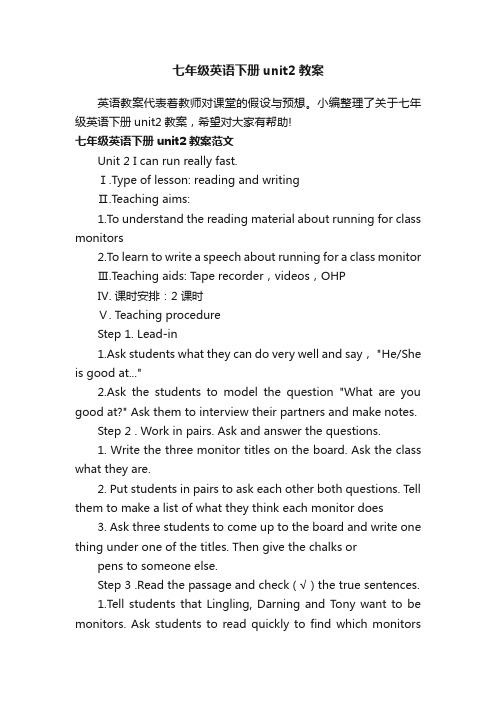
七年级英语下册unit2教案英语教案代表着教师对课堂的假设与预想。
小编整理了关于七年级英语下册unit2教案,希望对大家有帮助!七年级英语下册unit2教案范文Unit 2 I can run really fast.Ⅰ.Type of lesson: reading and writingⅡ.Teaching aims:1.To understand the reading material about running for class monitors2.To learn to write a speech about running for a class monitorⅢ.Teaching aids: T ape recorder,videos,OHPⅣ. 课时安排:2 课时Ⅴ. Teaching procedureStep 1. Lead-in1.Ask students what they can do very well and say, "He/She is good at..."2.Ask the students to model the question "What are you good at?" Ask them to interview their partners and make notes.Step 2 . Work in pairs. Ask and answer the questions.1. Write the three monitor titles on the board. Ask the class what they are.2. Put students in pairs to ask each other both questions. Tell them to make a list of what they think each monitor does3. Ask three students to come up to the board and write one thing under one of the titles. Then give the chalks or pens to someone else.Step 3 .Read the passage and check ( √ ) the true sentences.1.Tell students that Lingling, Darning and Tony want to be monitors. Ask students to read quickly to find which monitorsthey want to be.2. Ask students to read again. This time they can use their fingers to skim through and underline the things Lingling,Darning and Tony are good at.3. Ask students to check in pairs and elicit answers from the whole class.4. Ask students to read the sentences on page 11, and talk about them in pairs and guess the answers.5. Ask students to read the passage again and decide if the sentences are true or false. If false,then say why.6. Ask students to check with their partners.If their answers are different,tell them to go back to the text,read again and check.7.Ask students to read out the sentences and say if they are true or not. If not ,ask them to say why.Step 4 Underline the correct words.1. Ask students to work in pairs. Tell them to read through the passage and choose the correct words.2. Check answers by reading the passage aloud and pausing to allow the whole classto complete it with the correct words.Step 5 Complete the sentences with the correct form of the expressions from the box.1. Ask students to look at the expressions in the box.2. Ask students complete the sentences on their own and be careful with the language forms.3. Check in pairs. Elicit answers from the whole class in full sentences.Step 6 Work in pairs. Choose the best people in your class to be the monitors in Activity 1.Say: who they are and what job they can do and why they can do it1. Write titles of the three monitors across the board.2. Ask the class for two volunteers for each monitor. Write their names underneath.3. Put volunteers in pairs to talk about what they are good at, can do well and how they can help.4. Ask the rest of the students to make a table as below with three questions about their abilities to ask the volunteers. Put it on the board.Questions Student 1 Student 2 Student 3 Student 4 Student 5 Student 6Good at?Can do?Can help?5.Tell students to talk in groups about their notes,and decide who should be their monitors and say why.Step 7 Homework1. Remember the new words and expressions in Unit2.2 . Write a passage about one of the monitors in Activity 5.Ⅵ Blackboard showingⅦ Self-reflection.英语教学非智力因素探讨1.中学英语教学中非智力因素发展现状1.1中学生普遍缺乏真正的学习动机学习动机和学习兴趣是学生非智力因素中非常重要的一部分,兴趣是最好的教师,只有学生能够真正对英语感兴趣,才能让学生产生对英语的内在需求,才能真正激发他们的非智力因素。
七年级英语下学期Unit2教案设计
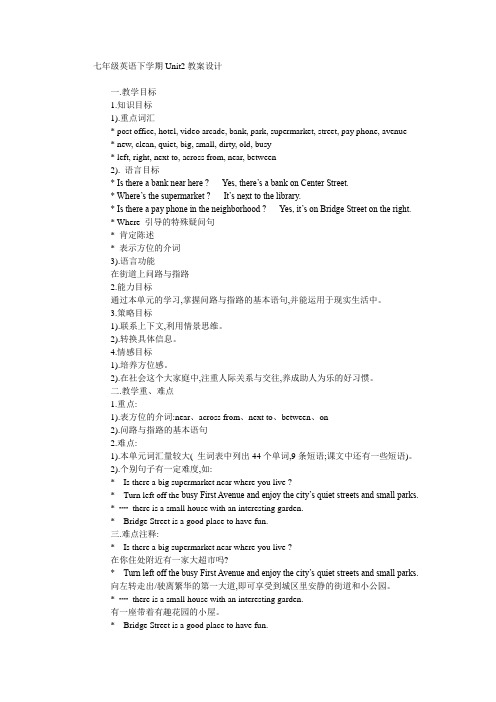
七年级英语下学期Unit2教案设计一.教学目标1.知识目标1).重点词汇* post office, hotel, video arcade, bank, park, supermarket, street, pay phone, avenue * new, clean, quiet, big, small, dirty, old, busy* left, right, next to, across from, near, between2). 语言目标* Is there a bank near here ? Yes, there’s a bank on Center Street.* Where’s the supermarket ? It’s next to the library.* Is there a pay phone in the neighborhood ? Yes, it’s on Bridge Street on the right.* Where 引导的特殊疑问句* 肯定陈述* 表示方位的介词3).语言功能在街道上问路与指路2.能力目标通过本单元的学习,掌握问路与指路的基本语句,并能运用于现实生活中。
3.策略目标1).联系上下文,利用情景思维。
2).转换具体信息。
4.情感目标1).培养方位感。
2).在社会这个大家庭中,注重人际关系与交往,养成助人为乐的好习惯。
二.教学重、难点1.重点:1).表方位的介词:near、across from、next to、between、on2).问路与指路的基本语句2.难点:1).本单元词汇量较大( 生词表中列出44个单词,9条短语;课文中还有一些短语)。
2).个别句子有一定难度,如:* Is there a big supermarket near where you live ?* Turn left off the busy First Avenue and enjoy the city’s quiet streets and small parks.* ┉there is a small house with an interesting garden.* Bridge Street is a good place to have fun.三.难点注释:* Is there a big supermarket near where you live ?在你住处附近有一家大超市吗?* Turn left off the busy First Avenue and enjoy the city’s quiet streets and small parks.向左转走出/驶离繁华的第一大道,即可享受到城区里安静的街道和小公园。
七年级英语下册 unit 2教案

七年级英语下册Unit 2教案Where’s the post office ? (Go for it Grade7 boo kⅡ Unit2) Teaching contentUnit 2 ( section A and section B)Teaching aims:1.to learn how to ask for directions on the street.2.to learn how to give directions on the streetTeaching important pointsDescribe the location of the buildingTeaching difficult pointsUnderstand the instruction of the direction, the use of the phrase between…and…,across …from….Teaching aids:Tape-recorder, epidiascope, computer, map.Teaching methods:Individual, pair and group work to make every student work in class. gamesTeaching Time :45 minutesTeaching procedures:Step1: Warming-upT: What’s the weather like today? If it is fine and you are free, would you like to travel? If you don’t know the way when you travel, can you ask the way in English? If you can’t, just follow me.Step 2:Lead-inAsk some students to the blackboard to demonstrate the prepositions of location, across from, next to, between… and… ,on ,in front of, behind to other studentsStep 3:presentationShow the picture of page7 on the big screen. Ask the students to describe the location of the buildings. Use the prepositions in step2.Step 4:practiceDraw a sketch map, ask students to fill the building’s name accordingto the indicationStep 5: PresentationT: Tomorrow is Saturday. I want to borrow some books from the library. But I don’t know the way. Can you show me the way? Introduce the phrases and sentences: turn left\turn right \on the left\on the right\go straight Is there a…… near here? Excuse me.Step 6:PracticeShow a street map on the big screenT: Where is the bookshop?Could you please show me the way?Step 7:ConsolidationT: Next Monday, I will visit some place. I’ll give you the direction, and please tell me where I’ll visit.Step 8:GameNext Tuesday is my birthday. I’m going to some places to buy somethings. Follow my instruction and stick the building’s names at the proper place. If you are right, you can get the invitation of my birthday.Step 9:SummaryIn this class we’ve learned how to describe the location of the building and how to ask and give the directions.Step 10:AssignmentDraw a sketch map of your city. Describe the way of your home to your school.四川省南充市延安路美亚学校张正蓉。
七下英语教案unit2新课标
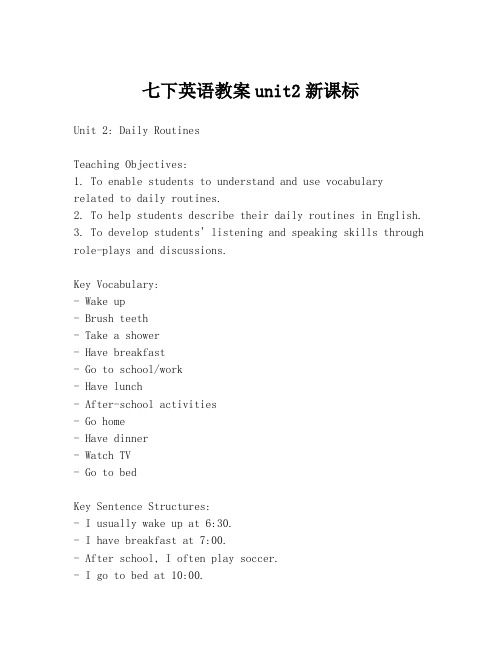
七下英语教案unit2新课标Unit 2: Daily RoutinesTeaching Objectives:1. To enable students to understand and use vocabularyrelated to daily routines.2. To help students describe their daily routines in English.3. To develop students' listening and speaking skills through role-plays and discussions.Key Vocabulary:- Wake up- Brush teeth- Take a shower- Have breakfast- Go to school/work- Have lunch- After-school activities- Go home- Have dinner- Watch TV- Go to bedKey Sentence Structures:- I usually wake up at 6:30.- I have breakfast at 7:00.- After school, I often play soccer.- I go to bed at 10:00.Teaching Procedures:1. Warm-up Activity (5 minutes)- Begin with a quick discussion about what students do on a typical day.2. Vocabulary Introduction (10 minutes)- Introduce the key vocabulary using pictures or flashcards.- Elicit the meaning of each word and provide examples.3. Listening Practice (10 minutes)- Play an audio recording of a dialogue between two students discussing their daily routines.- Ask students to identify the activities mentioned and write them down.4. Speaking Practice (15 minutes)- In pairs, students take turns asking and answering questions about each other's daily routines using the key sentence structures.- Example: "What time do you usually wake up?" "I usually wake up at 7:00."5. Role-play Activity (15 minutes)- Divide the class into groups of three or four.- Assign roles (e.g., family members, friends) and have students create a dialogue about their daily routines.- Encourage the use of the key vocabulary and sentence structures.6. Grammar Focus (10 minutes)- Introduce the use of "usually," "often," and "sometimes" to describe frequency of activities.- Provide examples and have students create their own sentences.7. Writing Task (10 minutes)- Ask students to write a short paragraph describing their typical day, incorporating the vocabulary and sentence structures learned.8. Wrap-up (5 minutes)- Review the key points of the lesson.- Assign homework: Students are to write a short essay about their ideal daily routine.Assessment:- Observe students during the role-play and speakingactivities to assess their understanding and use of the language.- Collect the writing tasks for a more formal assessment of their language skills.Materials:- Flashcards with vocabulary words- Audio recording of a dialogue- Handout with key sentence structuresDifferentiation:- Provide additional support to students who struggle withthe language by pairing them with stronger students.- Challenge advanced students with more complex sentence structures or by asking them to write a longer essay.Homework:- Write a short essay describing an ideal daily routine, incorporating the vocabulary and sentence structures learned in class.Reflection:- After the lesson, reflect on the effectiveness of the activities and consider any adjustments needed for future lessons.。
新课标英语七年级unit2教案
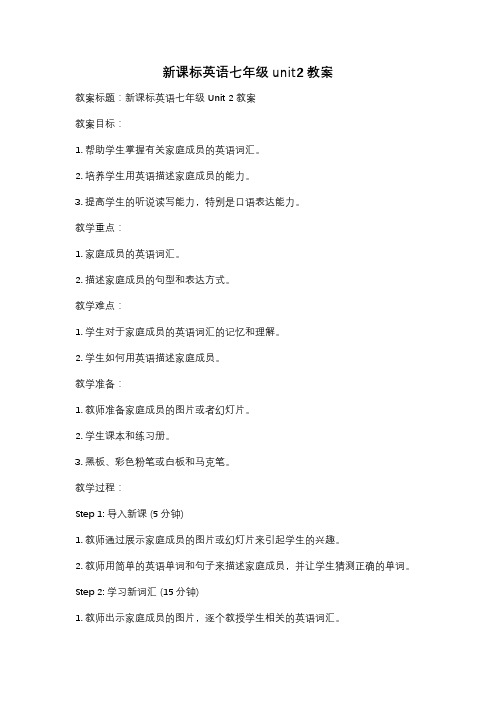
新课标英语七年级unit2教案教案标题:新课标英语七年级 Unit 2 教案教案目标:1. 帮助学生掌握有关家庭成员的英语词汇。
2. 培养学生用英语描述家庭成员的能力。
3. 提高学生的听说读写能力,特别是口语表达能力。
教学重点:1. 家庭成员的英语词汇。
2. 描述家庭成员的句型和表达方式。
教学难点:1. 学生对于家庭成员的英语词汇的记忆和理解。
2. 学生如何用英语描述家庭成员。
教学准备:1. 教师准备家庭成员的图片或者幻灯片。
2. 学生课本和练习册。
3. 黑板、彩色粉笔或白板和马克笔。
教学过程:Step 1: 导入新课 (5分钟)1. 教师通过展示家庭成员的图片或幻灯片来引起学生的兴趣。
2. 教师用简单的英语单词和句子来描述家庭成员,并让学生猜测正确的单词。
Step 2: 学习新词汇 (15分钟)1. 教师出示家庭成员的图片,逐个教授学生相关的英语词汇。
2. 教师通过图片和发音帮助学生记忆和理解新词汇。
3. 学生跟读和模仿教师的发音。
Step 3: 学习句型和表达方式 (20分钟)1. 教师通过示范和练习,教授学生如何用英语描述家庭成员。
2. 教师引导学生使用句型 "This is my..." 和 "These are my..." 来描述家庭成员。
3. 学生进行口语练习,以巩固所学的句型和表达方式。
Step 4: 听力训练 (10分钟)1. 教师播放一段关于家庭成员的对话录音。
2. 学生听录音并回答相关问题,以提高他们的听力理解能力。
Step 5: 读写训练 (15分钟)1. 学生阅读课本中有关家庭成员的文章,并回答相关问题。
2. 学生完成练习册中的写作练习,描述自己的家庭成员。
Step 6: 小结和作业布置 (5分钟)1. 教师对本节课的内容进行总结和复习。
2. 布置家庭成员的作业,要求学生用英语写一篇关于自己家庭成员的短文。
教学延伸:1. 学生可以进行口语对话练习,描述自己的家庭成员。
七年级英语下册unit2教案
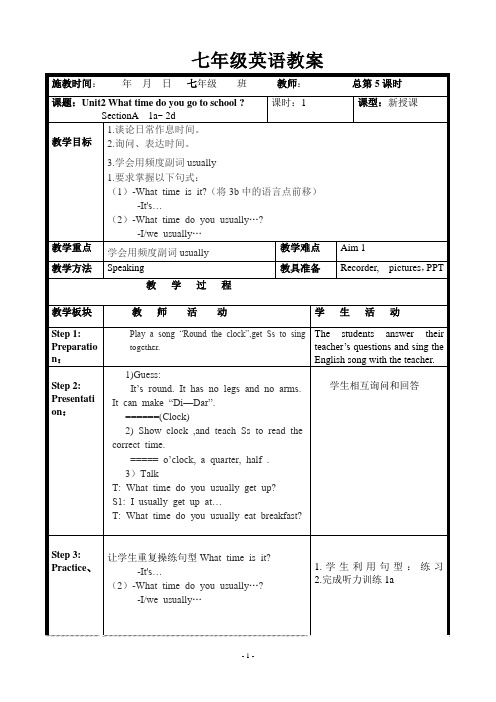
七年级英语教案施教时间:年月日七年级班教师:总第5课时课题:Unit2 What time do you go to school ?SectionA 1a~ 2d课时:1 课型:新授课教学目标1.谈论日常作息时间。
2.询问、表达时间。
3.学会用频度副词usually1.要求掌握以下句式:(1)-What time is it?(将3b中的语言点前移)-It's…(2)-What time do you usually…?-I/we usually…教学重点学会用频度副词usually教学难点Aim 1教学方法Speaking 教具准备Recorder, pictures,PPT 教学过程教学板块教师活动学生活动Step 1: Preparatio n:Play a song “Round the clock”,get Ss to singtogether.The students answer theirteacher’s questions and sing theEnglish song with the teacher.Step 2: Presentati on:1)Guess:It’s round. It has no legs and no arms.It can make “Di—Dar”.======(Clock)2) Show clock ,and teach Ss to read thecorrect time.===== o’clock, a qua rter, half .3)TalkT: What time do you usually get up?S1: I usually get up at…T: What time do you usually eat breakfast?学生相互询问和回答Step 3: Practice、让学生重复操练句型What time is it?-It's…(2)-What time do you usually…?-I/we usually…1.学生利用句型:练习2.完成听力训练1aStep4 : Dialogue making.小组活动。
七年级英语下unit2全英文教案五篇

七年级英语下unit2全英文教案五篇第一篇:七年级英语下unit2全英文教案七下第二单元教案第一课时(Section A 1a-2c)(Listening & speaking)Language functions: Is there a bank near here? Yes, there is.It’s on Center Street.Where is the supermarket? It’s next to the library.It’s between the restaurant and the supermarket.Vocabulary: post office, park, bank, supermarket, pay phone, street , across from , in front of ,behind, there, avenue, bridge, Across, across from, next , next to ,between, front, in front to, behindImportant point: Is there a supermarket ? Yes, there is./No, there is not where is ……? It is in front of ……Difficult point: Is there a supermarket ? Yes, there is./No, there is not where is ……? It is in front of ……Learn to ask for and give directions in conversations.Ability target:Train students’ listening and speaking skills.Train students’ communicative competence.Emotion target:All the buildings make our city beautiful.Thank the designers and the workers.Thanks for their hard work.Teaching steps: Step1 Warming-up and revision 1.Enjoy the chant of Grade 6’s Unit 2(以小学熟悉的chant能快速地引起学生的兴趣,让他们迅速地投入上课状态,同时此chant为后面做好铺垫)Where is the post office ? Next to the hospital.Where is the hospital? Next to the cinema.Where is the cinema ? Next to the bookstore.Where is the bookstore ? Go straight ahead.2.Greeting &revise Unit 1 Where are you from? What language can you speak?Where do you live?I live in China/Zhejiang/Pingyang/---Then ask ―What’s this ?‖---It’s a map.---Yes.It’s a map of China.Is this a map?(Show the map of 1a)Step2 word-teaching 1.Direct Ss’attention to the picture on the screen and ask Ss ―What’s this?‖,present the names of the places on the board.(用ppt引出地点,学生可以更直观地感知并掌握单词)2.Give plenty of opportunity for both choral and individual repetition of the new words.(中学生爱表现自己,这步设计可以更好地让学生学习英语的乐趣)Step 3.Match ,listen and pratice1.Finish 1a then check.2.Do 1b listen and check.(提高学生听的能力)3.Work in pairs,then ask two pair to act(让学生在使用中学习英语,以增强信心)Step 4.Teach the prepositions 1.Revise-Where is the soccer ball?(温故而知新)It’s in/on/under the box.2.Teach It’s near/next to /behind/in front of /across from/between –and--(让学生更好地理解这些介词的意义)3.Put the prepositions on the board, have Ss repeated.4.Finish 2a then check 4-6-2-3-5-15.Show the picture one by one by asking and answering--Where is the pay phone?--It’s on/-the Green Street(及时复习巩固)Step 5.Listening 1.Reading the words &sentences before listening(培养学生的听力技巧)2.Play the tape ,listen & check (及时反馈,即使评价,提高学习效率)Step 6.Consolidation and pairwork 1.Fill the blank ,then check(提高上课学习效率,巩固新知识)2.Pairwork : Where is the---? It’s across from/ next to/ between… and …/ on/in front of/behind---(提高学生听说与交际能力)Step 7.Homework 1.Pair works,two students draw the map, one acts as a policeman, the other acts as a a person who is ask the way.2.Draw a sketch map of your home to school or the way to your partner.3.Finish homework 2-1,2 Blackboard design-Is there a...? post office-Yes,there is.It’s on...street./ libraryNo,there isn’t.hotelWhere is the----? restaurant-It’s on/in front of / behind/across from/ bank Near/next to /between—and--supermarketparkpay phone第二课时(Section 3a-4)(Reading & speaking)一.Teaching Aims and Demands1.Ability ObjectTrain students’ listening and speaking skills.Train students’ communicative nguage goals:learn to ask for and give directions on the street.Moral objects On weekends or holidays, invite your friends to your house to have a good time.4.Teaching Key points: Review the key words in this unit二、Teaching steps: Step 1.Warming-up and revisionDaily GreetingStep 1.Warming-up and revision(温故而知新)Daily Greeting(融洽师生之间的关系)Is there a post office near your house ?……Where is---?Then ask some questions about the picture of 3aStep 2.Pesentation.(传授新知识)--Is there a supermarket in the picture?---Yes it is.--Where is it?---It’s between the hotel and the post office.---There is a traffic sign.What does it mean?---It means ―Turn left ‖What other traffic signs do you know? What do they mean?,In the same way present turn lright、/take the...turning.go straight Go up/go down/on the left /right /on your left /right step 3.Reading and speaking1.Read the conversation and find Paul and Nancy in the picture.Then show the position(训练学生的听说读的能力)2.T—Paul SS—Nancy Ask and answer Can you draw the line.?Who can ?Show the line.3.Work in pairs step 4.Work on 3b(巩固新知识,加强英语的综合运用能力)1.Work in pairs(T-go around to guide the student)2.Ask some pairs to act Step5.Summary and Consolidation1.Summary(学习方法指导,加强培养学生的自主学习能力)-Excuse me.Is there a/an … near here?-Yes, there is./ No, there isn’t.-Where is the …?-Just go straight and turn left.It’s down Bridge Street on the right.It’s …behind next to between … and …across from in front ofon-Thank you very much.-You’re welco me.2.Pairwork Who is the most warm-hearted policeman?(提高学生的听说与交际能力)--Excuse me.Where is the bank ?--go straight down Center Street, turn left at Xingfu Street There is a bank on the right.It’snext to the bookshop…Step 6.Guessing Game.(游戏是学生喜欢的活动形式,其可以增加学习英语的趣味性)Goal: This activity provides an oral review of where a place is.Procedures: Invite a student to come to the front of the classroom.And then describe a place which thestudent are familiar with.For example, he or she may say, it is on Center Stree t.It’s next to the supermarket.While he or she is describing the rest take turn asking.Is it a school ? Is it a pay phone? Etc.The game goes on until they can guess it.(提高学生综合运用英语的能力)Step 7 Homework(作业是课堂的延续)1.Summary the sentences of asking and directing the direction2.Write down the route from your home to your school..Draw a picture of your ideal neighborhood.Make up a dialog between a police officer and a passer-by.Blackboard Design-Excuse me.Is there...? go straight Where is...? turn leftWhich is the way to...? turn righ tCan you tell me the way to...? take the...turning第三课时(SectionB 1a-4b)(Listening Reading &writing)一、Teaching aims 1.Vocabulary:open, dirty, old, market, quiet ,house,welcome ,garden, enjoy, walk through ,beginning,tour, visit, place,have fun ,if hungry, 2.Ability target: Train students’ listening ,speaking ,reading &writing skills.Train students’ communicative competence.3.Moral Object Everyone in school take the responsibility to keep our environment clean and tidy.二、Key Points Key Vocabulary.Target language三、Teaching difficulties 1..Practice the adjectives using thetarget language, 2.Train students’ listening ,speaking ,reading &writing skills.3.students’ communicative competence.四、Teaching steps: Step 1.Warming-up and revision Enjoy an English song(用歌曲自然地把学生引入课堂,且能激起学生学习英语的兴趣)Greeting.(融洽教师与学生之间的了解,融洽彼此的关系)Draw a stick-figure picture on the screen,have Ss say the routes between places.Point to two supermarkets.one is big,one is small, have Ss tell the difference, elicit the two adjectives big、small fromSs.(自然地导出新课的内容)Step 2.word-teaching.Show three pairs of items,elicit the three pairs of antonyms.clean-dirty new-old queit-busy.Reinforce with examples Ss familiar with,for example our class is clean,but the W.C is dirty,etc.(在使用中学习英语,在学中用,体现了新课程的理念).Refer to 1a,2a, in Section B.Step3.ListeningWork on 2a,2b.(训练学生的听力,以提高他们听的能力)Check the answers in 2b by asking one student to draw the map of Michaels’ neighborhood on the board.Step 4.Reading (加强学生阅读策略的培养,并为下一步的写打下基础)1.Ask Ss ―Do you have a school trip?‖ ―Do you want to havea school trip?‖―Why?‖etc.Elicit the newwords and phrases.2.work on 3a Before-Reading.Tell Ss that it’s importannt for us to get information from a tour guide if we want to have a tour.Ask Ss ―What info rmation can you from a tour guide?‖elicit answers from Ss.(take notes as Ss answering)the place to visit: the way to the place: how to go to the place:how is the place: While-Reading.Have Ss look at the lists of the items on the board and find the information about in 3asection B..Have one student put the answers on the board..Tell Ss to read the passage aloud,go around and monitor them and help with pronunciation.After-Reading.Say―I don’t live in Yuyang , tell me some interesting places in Yuyang ?‖.Elic it information from Ss,Step 5 working on 3b&writing1.working on 3bthen check(提供一些阅读信息,提供写导游指南的素材)2.Tell Ss to chooose one of the places and write down the four items of the place,and try to link theinformation into a tour guidar..Select some tour guides from Ss at random,check them on the screen,have Ss judge the best one.Step 6.Homework(温故而知新)1.Pair works,two students draw the map, one acts as a policeman, the other acts as a a person who isask the way.2.Draw a sketch map of your home to school or the way to your partner.Blackboard Designclean dirty welcome garden district new old take a walk through quiet busy beginning hungry...Period 4(Revise of Unit 2)一.Teaching Aims and Demands1.Knowledge objectsReview all the key words presented in this unit.Read an e-mail and draw a route2.Ability ObjectTrain Ss’ Reading and writing skill.Moral objects On weekends or holidays, invite your friends to your house to have a good time.4.Teaching Key points: Review the key words in this unitTeaching steps:Step 1.Warming-up and revisionEnjoy an English song(提高学生的学习兴趣)Greeting.Step2 work on shelfcheck-3.1 Scan and find the answers to these questions.(培养快速阅读的能力)(1)When is he arriving?(2)Does he know the way?(3)What does Mike do? 2.Read an e-mail and draw a route 3.read aloud then fill the letter of Jenny(训练学生英语写作的能力)Step 3 Summary1.Summary:(培养学生及时总结的能力,并做一定的示范)Asking the Way:Excuse me.Is there a …near here?Where is the nearest …?Can you tell me how I can get to the…? Can you tell me how to get to the …? Could you tell me the way to the …, please?Which is the way to…?Do you know the way to…Showing the Way:Go down this street./ Walk along this road.Take the first turning on the right./Turn left at the first turning.It’s on your right/left./ It’s next to …It’ll only take you about 10 minutes if you walk there.Step 4 Pairwork(灵活运用所学词汇和句型,培养学生的观察力和对信息的整合能力,训练学生的口语表达能力和演讲技巧)---Excuse me ,where is----/Is there a---Work in pairs---actStep 4 Exercise(目的:复习巩固相关词汇与句型;激发同学之间用英语相互交流的欲望,增强学生的学习兴趣,增进同学之间的友谊)1.Fill in the blanks1.There’s a cinema next ____ the shop.2.____ the left side ofthe room, there’s a desk.3.-I’m sorry I can’t help you.-_______________________________.4.Please come to the front and stand ____________ the class.5.A: ________ _______, where is the nearest police station, please?B: I’m _______, I don’t know.Please ________ that man.A: Thank you _______ ________ _______.Excuse me, where is the police station, please?C: _______ over there, next ________ the post office.A: Thank you ________ _______.C: Not ________ _______.6.A: Excuse me.Which is the____ to East Park, please?B: Let me see.Er, walk _______ this road and ____ right.Go ____ until you _____ the end.You’ll___ the park in front of you.7A: Excuse me.Can you tell me ____ to the post office, please?B: Sure.Go ____ this street and ____ right.Then you’ll see a tall building.That’s the _____ ____, and it s between the zoo ____ the fruit shop.You can’t _____ it.A: Is it ____ from here?B: No, it s quite near.It’ll only ____ you about 10 minutes if you walk there.A: Thanks a lot.B: You’re welcome.答案见课件Step 5.Homework()1.Write a letter to your friend who will visit you but he doesn’t know the way.?2.Finish the exercises below : 1.请问,去车站怎么走?Excuse me.Could/ Can you tell me the way to the station?2.请问,去警察局怎么走?Excuse me.Which is the way to the police station? 3.请问,去动物园我该走哪条路? Excuse me.Which way shall I take to the zoo?4.劳驾,最近的邮局在哪儿?Excuse me, where is the nearest post office?5.请问,你能帮我找到那家水果店吗?Excuse me.Could/Can you help me find the fruit shop6.劳驾,往第十四中学怎么走?Excuse me.How can I get to No.14 Middle School?7.劳驾,附近有医院吗?Excuse me.Is there a hospital near here8.劳驾,去书店怎么走第二篇:全英文教案 Unit2Teaching Plan(45mins)Unit2 English around the world Part 1 :Analysis of teaching materialThe theme of this class is “English language and its development, different kinds of English”.Researching the topic of the development of the history of English language, which can make students strengthen the understanding of the English language, especially for the understanding of the trend of English development.After finished this class, the students can comprehend the variety levels and plurality of English language, which can help students develop the consciousness of intercultural.Part 2: Teaching Aims1.Knowledge Objects①Talk about English and its development, different kinds of English.②Talk about the difficulties in language communication.③Learn to make dialogue by using request & command.④Learn to transfer from Direct Speech into Indirect Speech.⑤L earn to organize ideas and give opinions by the way of brainstorming.2.Ability Objects(1)Important word and phrase Subway, elevator, petrol, gas, official, voyage, conquer, native, come up, apartment, actually, base, at present, gradually, vocabulary, make use of, latter, identity, fluently, frequently, usage, command(2)Grammar and sentence①English is a language spoken all around the world.②Thereare more than 42 countries where the majority of the people speak English.③The number of people who learn Engl ish as a foreign language is more than 750 million.④In China students learn English at school as a foreign language, except for those in Hong Kong, where many people speak English as a first or a second language.3.Moral ObjectsLet the students obtain the knowledge about the development of English language by reading, expand international horizons, aggrandize the culture consciousness, arouse their enthusiasm for English learning.Part 3: Teaching Key Points and Teaching Difficulties1.To be able to get the main idea from the text.2.To be able to solve the problem by analyzing.3.To be able to use the different learning strategies for different reading purposes.Part 4: Teaching method1.Scenario communication method2.Task based Language Teaching method3.The heuristic teaching methodCreate the scenarios, lead in the topic, group discussions and exchange, inspire the learning initiative of student with the heuristic teaching method Part 5:Teaching Procedures Step1: Warming upLet the students look at the following picture, then ask them some questions like these: Which words in the picture are British English or American English? Which country do you think has the most English learners? Step2:Lead inI play a short video about people from England making voyages to conquer other parts of the world, then ask the students: Why is English the most widely used in so many countries? Why has English changed over time?Step3:Fast reading1.Let the students read the text as quickly as they can, then decide whether the statements are true or false:(1)There is no difference between American English and British English.(2)Written English is the same in both American English and British English.(3)Sometimes people from the two countries have difficulty in understanding each other.(4)The English language in the world always stay the same as the language used in Britain.2.Show the students some important words and expressions.(1)include包括,包含(2)play an important role / part in 扮演重要角色(3)even if / though 即使,即便(4)a large number of 许多,大量的(5)communicate with 和...交流(6)be based on 建立在......的基础上(7)make use of 利用,使用 Step 4: Careful reading 1.Let the students read the passage carefully and then make a time line of the development of English.2.Let the students read the passage again and fill in the blanks with the words from the text.It is not easy for a Chinese person to speak English as ___ as a ___ English speaker.One reason is that English has a large ___.It also has different usage in different English speaking countries.If you use “flat”instead of “___”, people in America will know you have learned British English.If you use the word “___”instead of “lift”in Britain, people will know you have studied American English.3.Let the students listen to the text carefully and repeat the sentences.Step 5 :Group workAsk and answer the questions like these: When did five to seven million people speak English? Why did English begin to be spoken in many other countries? Which country may have the largest number of English learners? Step 6 :Practice Retell the history of English and tell the differences of ancient English and modern English, British English and AmericanEnglish.Step 7:SummaryAnswer questions: Tell us what did you learn from this lesson? Why do you think people all over the world want to learn English?Then give “The road to modern English”.Step 8:Homework1.Go over the text and try to learn all the useful words and expressions in this part by heart.2.Write a passage about your English learning.Part 6: After-class reflectionThe essential aim of English teaching is to promote the skills of listening, speaking, reading, writing, and the ability of comprehension, and to strengthen their consciousness of cross cultural communication.The four skills link closely, and they do not exist in isolation, this lesson will integrate these four links to the whole teaching process, which make students basically achieved the knowledge of this lesson and enable students to systematically understand the knowledge they have learned.At the same time, we can achieve the teaching aim of this class.第三篇:七年级英语下unit2课件七年级英语下unit2课件Can you play the guitar?一.Knowledge and abilities goals:1.vocabulary:dance,swim,sing,play chess , paint ,speak English, play the guitar2.How to use Model verb” can”.3.Listen ing and speaking skills and communicative competence.二.Teaching method: Listening and speaking methods.Pair works.三.Moral goals: Encourage students to express their abilities.Content of courses: In this period, students will learn some names of clubs ,such as art , music, chess club, swimming club, etc.students will learn the drills :Do you want to join…club ?Can you …?四.Importance and difficulty: canTeaching Aids: A tape recorder.Some pictures.A projector Some sports things, such as volleyball, basketball, etc.Preparation test paper for lessons before class.五.Teaching Time: 4 periods Period 1(Section A: 1a-2d)授课人:______ 授课班级: _____ 授课时间:2016年___月___日____午第____节1.Knowledge Objects: Learn to talk about abilities.Know something about the culture of clubs.Can you/he..?What can you do? What club do you want to join?can, can’t, draw, dance, swim, speak, walk.2.Teaching key point: can3.Teaching Difficult point: can4.Teaching Procedures:Step 1.Lead-inEnjoy a song I’m a musicianT: Do you want to be a musician? S:T: Can you play the piano? S…T: What can you do? S: I can…T: What about you? S:T: OK, now please show your talent and tell us what you can do.Ask one of the students come to the front and do the action.Ask other students to guess what he or she can do.Step 2.PresentationT: Look at the pictures.What are they doing? S:Step 3 Pair workLook at the pictures.Ask and answer like this:A: Can you play basketball?B: Yes, I can./ No, I can’t.Can you…?Step 4 PresentationShow some pictures of famous stars.Practice the third person “he, she, they”T: Where can you play chess? S:T: Yes, in a chess club.This term, we have a lot of clubs.What club do you want to join? S…T: Sounds great.Can you…?S: Yes, I can/ No, I can’tIf the answer is negative, guide students to say:S: No, I can’t.But I can learn it from others.Step5 Pair work A: What club do you want to join?B: I want to join the…A: Can you …?B: Yes, I can.No, I can’t.But I can learn it from others.Step 6 ListeningListen to 1bListen to 2a and 2b.Tell them to give special attention to listening activity(names of the clubs).Finish the tasks.Step 7 Pair workLook at 2b and talk about what the people can do the clubs they want to join.Step 7 Role-play the conversation 2d T: If you like telling stories.What club can you join?S: Story telling club.T: Right.Please read the conversation following the recording.Who wants to join the story telling club? Then role-play the conversation.Step 8 Explain some language points.Step 9 Homework第四篇:七年级上册英语unit2教案Period 1 Section A 1a1c Ⅰ.教学准备1.教师:录音机和录音磁带,多媒体课件、麦克风、自己的家庭照片。
英语七年级下-Unit2教案(完整版)

要点2 Europe
【思维导图】
要点2 Europe
【举例】
All Europe was then embroiled in the war. 当 时整个欧洲都被卷入了战争。
France is a European country. 法国是一个欧洲 国家。
People use “Eurasia” to refer to Europe and Asia. 人们用“欧亚大陆”来指代欧洲和亚洲。
关键词汇
11. 位于;坐落在 (v.)_____li_e____ 12. 完美的 (adj.) __p_e__rf_e_c_t__ 13. 更喜欢 (v.) ___p_r_e_fe__r__ 14. 滑雪 (v.)____s_k_i____ 15. 完成 (v.)___f_in_i_s_h___ 16. 接收者(n.)__r_e_c_e_i_v_e_r_
We can only finish half of the work this afternoon. 今天下午我们只能完成一半工作。 They couldn't finish doing the work well. 他们没能很好地完成这项工作。
要点7 finish
【应用】
(1) I just finished __p_l_a_y_i_n_g__(play) basketball.
要点3 excellent
【应用】(1)( B ) Tom is an excellent student in our class.(选出可以替换画线部分 的最佳选项) A. a bad B. a very good C. a beautiful
(2)My brother _e_x_c_e_l_s____ (excellent) at English speaking.
七年级英语下册Module2Unit2Goingtoseeafilm教案新部编本上海牛津版

优选授课授课设计设计 | Excellent teaching plan教师学科授课设计[ 20–20学年度第__学期]任授课科: _____________任教年级: _____________任教老师: _____________xx市实验学校Module 2 Garden City and its neighbou rs Unit 2 Going to seea film1Language focus:Using formulaic expressions to start a telephone conversation.e.g. Hello. May I speak to Kitty Li, please?Using adjectives to describe objectse.g. I love exciting films.Using imperatives to give instructions.e.g. Hold on. I’ll be back in a moment.Using the simple present tense to express feelings.e.g. We love e xciting films, but your mum doesn’t like this kind of film.Language skills:ListeningRecognize differences in the use of intonation in questions, statements(including approval and disapproval), commands, and respond appropriately.Use visual clues, context and knowledge of the world to work out the meaning o f an unknown word and a complete expression.Understand the speaker ’s intention, attitude and feelings through his/her choiceand use of language, gesture and facial expressionSpeakingUse gestures and facial expression to convey meaning and intention.Maintain an interaction by replyingReadingUse visual clues, context and knowledge of the world to work out the meaning of anunknown word and a complete expressionUnderstand intention, attitude and feelings stated in a text by recognizing features such as the choice and use of language.Materials:Student ’s Book 7B page 33Cassette 7B and a cassette playerWorkbook 7B page 19Preparation:Cue the cassette.Pre-task preparationLanguage learning activity(This section aims at providing students with opportunities to practise the language/vocabulary needed or become familiar with the background for the task thatfollows.1.Say: I went to the cinema yesterday and saw (name of the film). It’s a/an ___ film. It ’s about ⋯Ask the class: Have you been to the cinema recently? Which film did you see? What’s it about? To elicit:I saw (name of the film).It ’s a/an _______ film. It’s about⋯2.Play the recording: Look and read. Students listen and follow in their books.3.Play the recording again. Students listen and repeat.4. Write:‘So do I’,‘Neither do I’ and ‘So would I’ on the board. Invitea more able student to come forward and ask and answer questions with you like this: Teacher : What kind of film do you love?Student : I love __ films/films about ______ .Teacher : So do I. What kind of film don’t you like?Student : I don ’t like ____ films/films about ______ .Teacher : Neither do I. What would you rather see: ______ films or _____ films?Student : I ’d rather see ____ films.Teacher : So would I.5.You may have students work in pairs and conduct a similar dialogue to talk about the kinds of films they like and do not li ke. Walk around, offering help and guidance to the less able students if necessary.ConsolidationGrammar Practice Book 7B page 25Workbook page 192Language focus:Asking ‘Wh- ’ questions to find out about a specific objecte.g. Which film would you like to see? Using adverbials toexpress degreee.g. No, I don’t like________ films very much.Using the simple present tense to express feelingse.g. I like this kind of film.Language skills:ListeningListen for specific informationUnderstand the spea ker ’s intention, attitude and feelings through his/her choice and use of language, gestures and facial expression SpeakingUse gestures and facial expression to convey meaning and intentionUse appropriate intonation and stress, and vary volume, tone of voice, andspeed to convey intended meanings and feelingsOpen an interaction by eliciting a responseMaintain an interaction by replyingReadingUse visual clues, context and knowledge of the world to work out the meaning of anunknown word and a complete expression.Materials:Student ’s Book 7B page 34Some English film poster from magazines/ newspapers.Preparation:Collect some English film poster from magazines/new spapers and bring them to class.ConsolidationGrammar Practice Book 7B page 263Language focus:Using modals to make suggestionse.g. Can we see the two-five show in the afternoon?Using prepositions to indicate time.e.g. Can we see the ten show in the morning?Using formulaic expressions to respond to suggestionse.g. S orry, Kitty. I can’t make it thenLanguage skills:ListeningRecognize differences in the use of intonation in question, statements(including approval and disapproval), commands, and respond appropriatelyListen for specific informationSpeakingUse appropriate intonation and stress, and vary volume, tone of voice, and speedto convey intended meanings and feeling.Use gesture and facial expression to convey meaning and intention.Open an interaction by eliciting a responseMaintain an interaction by replyingMaintain an interaction by asking and responding to others’ opinions.WritingGather and share information,ideas and language bu using strategies such as brainstorming, listing, questioning, and interviewingMaterials:Student ’s Book 7B page 35Cassette 7B and a cassette playerPhotocopiable page 30优选授课授课设计设计| Excellent teaching planPreparation:Cue the cassette. Make a copy of Photocopiable page 30for each student.Pre-task preparation1. Ask students to look at the film guide on page 34 of the student’s Book again. Teach them how to read the show times aloud, e.g. 10:20 a.m.-the ten twenty showin the morning, 2:45 p.m.-the two forty–fiveseven thirty show in the evening, etc.2.Play the recording: Read and think. Students listen and follow in their books.3.Have the whole class read the text in Read and think carefully. Ask: Which showcan Kitty. Mrs Li and peter see?To elicit: They can see the five forty show in the evening. You may invite a more able student to explain why.4. Tell students to complete Ask and answer on their own. Remain them to refer tothe film guide again to find the answers. When everyone has completed the exercise, check answers orally.4Language focus:Using adverbs to express sequencee.g. First, turn right.Using imperatives to give instructionse.g. Walk along Greet Street.Using connectives to link similar idease.g. Next, turn left and walk along Tree Road.Using prepositions to indicate positione.g. You will find City Cinema on your right.Language skills:ListeningListen for specific informationUnderstand the connection between ideas by recognizing linking words and phrasesSpeakingConnect ideas by using linking words or phrasesMaintain an interaction by replyingReadingUnderstand the connection between ideas by identifying linking words or phrasesWritingPlan and organize information and ideas by deciding on the sequence of contentDevelop written texts by using appropriate linking words or phrasesMaterials:Student ’s Book 7B page 36Cassette 7B and a cassette playerWorkbook 7B page 20优选授课授课设计设计| Excellent teaching plan Photocopiable pag e 31Preparation:Cue the cassette. Make a copy of Photocopiable page 31 for each pair of students.Pre-task preparation1.Review the adverbs of time: first, next, then and finally with students first.You may tell them how you go to school, e.g. First, I walk to the bus stop. Next,I take bus No.3. Then I get off the bus at Sunset Road. Finally, I walk for threeminutes and arrive at our school. Invite a more able student to tell the classhow he/she goes to school using the time adverbs.2.Draw a big map like the one in Read and say on the board. Give students a fewminutes to read Kitty’s instruction s in Picture 2.3.Play the recording: Read and say. Students listen and follow in their books.4.Play the recording again. Invite a students to come forward and draw the routeon the board while the rest of the class are listening to the recording for the second time.5. The whole class then checks whether their classmate has drawn the route correctly or not .Post-task activityWorkbook page 20ConsolidationGrammar Practice Book 7B page 275Language focus:Using adverbs to express sequencee.g. First, turn __.Using prepositions to indicate positione.g. You will find City Cinema on your ______.Using prepositions to indicate direction.e.g. Next, turn _______ into Tree Road.Using imperatives to give instructions and directionse.g. Turn ___ and walk along _____Language skills:ListeningListen for specific informationSpeakingConnect ideas by using linking words or phrasesMaintain an interaction by replyingReading优选授课授课设计设计| Excellent teaching planUnderstand the connection between ideas by identifying linking words or phrasesSelf-correct by using strategies such as reading further to clarify WritingPlan and organize information and ideas by deciding on the sequ ence of content Developwritten texts by using appropriate linking words or phrase.Materials:Student ’s Book 7B page 37Pre-task preparationReview the time adverbs: first, next, then and finally with students again. Drawa simple street map on the board like the one on page36 of the student’s Book. Ask a few of the more able students: How do you get to (a place) from (another place)? To elicit: first,⋯Next,⋯Then⋯ Finally,⋯ConsolidationGrammar Practice Book 7B page 28 to 29。
【教学方案】七年级英语下册第二单元教案Unit 2 Section A 第1课时教案(七下)
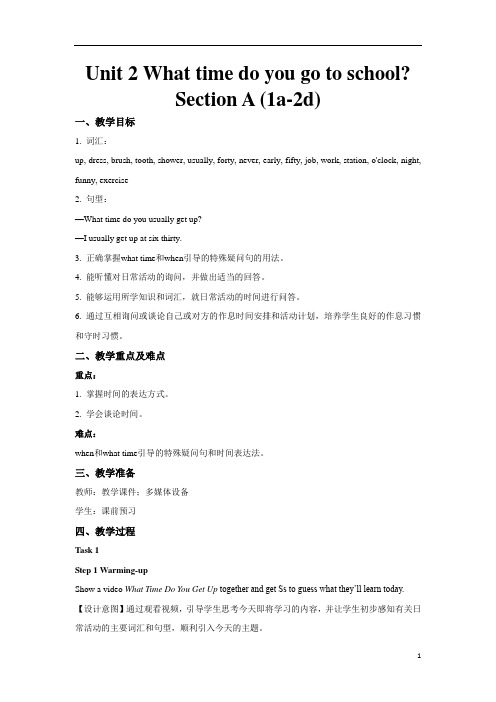
Unit 2 What time do you go to school?Section A (1a-2d)一、教学目标1. 词汇:up, dress, brush, tooth, shower, usually, forty, never, early, fifty, job, work, station, o'clock, night, funny, exercise2. 句型:—What time do you usually get up?—I usually get up at six thirty.3. 正确掌握what time和when引导的特殊疑问句的用法。
4. 能听懂对日常活动的询问,并做出适当的回答。
5. 能够运用所学知识和词汇,就日常活动的时间进行问答。
6. 通过互相询问或谈论自己或对方的作息时间安排和活动计划,培养学生良好的作息习惯和守时习惯。
二、教学重点及难点重点:1. 掌握时间的表达方式。
2. 学会谈论时间。
难点:when和what time引导的特殊疑问句和时间表达法。
三、教学准备教师:教学课件;多媒体设备学生:课前预习四、教学过程Task 1Step 1 Warming-upShow a video What Time Do You Get Up together and get Ss to guess what they’ll learn today.【设计意图】通过观看视频,引导学生思考今天即将学习的内容,并让学生初步感知有关日常活动的主要词汇和句型,顺利引入今天的主题。
Step 2 Pre-listeningRead and match1. Learn the new words and expressions.2. Read and match the words to their Chinese meanings.Let’s learnGet Ss to look at the pictures one by one and say what the phrases are.【设计意图】让学生熟悉新词汇,为后面的学习做铺垫。
- 1、下载文档前请自行甄别文档内容的完整性,平台不提供额外的编辑、内容补充、找答案等附加服务。
- 2、"仅部分预览"的文档,不可在线预览部分如存在完整性等问题,可反馈申请退款(可完整预览的文档不适用该条件!)。
- 3、如文档侵犯您的权益,请联系客服反馈,我们会尽快为您处理(人工客服工作时间:9:00-18:30)。
教师学科教案[ 20 – 20 学年度第__学期]任教学科:_____________任教年级:_____________任教老师:_____________xx市实验学校Unit 2 What time do you go to school?第一课时Section A (1a-2d)一、教学目标:1. 语言知识目标:1) 能掌握以下单词:up, get up, dress, get dressed, brush, tooth (pl. teeth) brush teeth, shower, take a shower, usually, forty, fifty, wow, never, early, job, work, station, radio station, o'clock, funny, exercise能掌握以下句型:①—What time do you usually get up? —I usually get up at six thirty.②—When do you go to work? —I usually go to work at eleven o'clock.③—He has an interesting job. —He works at a radio station.2) 用when和what time引导的特殊疑问句询问时间和时间的表达法;用所学的目标语言对生活和学习活动做计划,学会合理地安排作息时间。
2. 情感态度价值观目标:本部分的话题是“日常作息时间”,学习内容贴近学生的生活,因为学生的作息时间安排是非常有规律的。
通过互相询问或谈论自己或对方的作息时间安排和活动计划,可以培养学生良好的作息习惯和守时习惯。
二、教学重难点1. 教学重点:1) 掌握时间的简单表达方式。
2) 学习询问和谈论时间和制订作息时间表。
2. 教学难点:when和what time引导的特殊疑问句和时间的表达法。
三、教学过程Ⅰ. Warming-up and revision1. Greet the Ss as usual.2. Watch a short video program about daily activities.Ⅱ. Presentation1. 出示几幅反映日常事务(如:起床、上学、跑步等)的图画、幻灯片或播放课件,引导学生谈论这些日常事务go to school,get up,run,take a shower,eat breakfast等,学习有关的动词短语。
学生们观看教师出示的反映日常事务(如:起床、上学、跑步等)的图画、幻灯片或课件,谈论这些日常事务go to school,get up,run,take a shower,eat breakfast等,学习有关的动词短语。
2. 出示la部分的图片或幻灯片或播放该内容的课件,引导学生将词语与图画进行搭配。
学生们观看1a部分的图片或幻灯片或该内容的课件,将词语与图画进行搭配,完成la部分的学习任务。
Ⅲ. Presentation1. 出示一个可以转动时/分针的大钟,一边调整时间,一边询问学生时间“Whattime is it?”。
学生们在老师的帮助下回答时间:It's six o'clock. It's seven twenty. …(给学生们解释在英语中时间的简单的表达方式)2. 调整时钟到某个时间,然后说:I get up at 6:00.I go to school at 6:45.等;再询问学生:What time do you get up? 等,引导学生回答,从而引出本部分的重点目标句型。
学生们一边观看大钟,一边认真听老师的描述,然后回答老师的问题I get up at…,从而学习本部分的重点目标句型。
Ⅳ. Listening1. 播放1b部分的录音让学生听,引导学生根据所听到的内容,将时间与活动进行搭配。
2. 学生们听1b部分的录音,根据所听到的内容,将时间与活动进行搭配,完成1b部分的学习任务。
3. Check the answers:Ⅴ. Pair work1. 引导学生展开Pairwork活动,进行口语交际活动,学会运用what time引导的疑问句,用数词来询问和表达时间。
2. 学生们展开活动,完成1c部分口语交际的学习任务,学会运用what time引导的疑问句,用数词来询问和表达时间。
Ⅵ. Listening1. 让学生们先阅读2a部分的句子,理解大意。
然后播放2a部分的录音让学生听,引导学生根据对话内容进行填空。
(注意提醒学生们听对话填空的技巧:先听、记住应填的内容,做简单的(符号)记录,最后,在听第二遍的时候再进行单词的书写。
)2. 再播放2a部分的对话录音让学生听,引导学生写出Jim一家人的淋浴计划(时间)。
3. 学生们再听2a部分的对话录音,写出Jim一家人的淋浴计划,完成2b部分的教学任务。
4. Check the answers:Ⅶ. Pair work引导学生展开Pairwork活动,完成2c部分口语交际的教学任务。
提示学生们可以就1a部分的日常活动来进行问答。
e.g.T: S1, what time do you usually get up in the morning?S1: I usually get up at six thirty.T: And what time do you eat breakfast?S1: I usually eat breakfast at seven o'clock.Ⅷ. Role-play1. Ask Ss to read the conversation in 2c. Then answer the questions below:①Where does Scott work?②What time is his radio show?③What time does he usually get up?④What time does he eat breakfast?⑤What time does he usually go to work?2. 学生们阅读对话,然后回答上述问题。
老师让几位同学回答上述问题,然后和同学们一起校对一下答案。
看学生们的掌握情况。
应对话中学生们不明白的地方给予适当的解释。
3. Play the recording for the Ss to listen and repeat. Then let Ss work in pairs to practice reading the conversation. Then try to act it out.4. Ask some pairs to come to the front and act out the conversation. See which group does best.Homework:1. Remember the new words and expressions. Try to understand how to expresstime in English.2. Role-play the conversation with a partner after class.3. Write three short conversations to ask about your best friend's daily activities.板书设计:教后反思:第二课时Section A (Grammar Focus-3c)一、教学目标:1. 语言知识目标:1) 继续学习运用when和what time引导的特殊疑问句询问时间、运用数词表达不同的时间,通过对目标语言的学习使学生学会更合理地安排自己的学习和课活动时间。
能掌握以下句型:①—What time do you usually get up? —I usually get up at six thirty.②—When do you go to work?—I usually go to work at eleven o'clock. —He's never late for school.③—When does Rick eat breakfast? —He eats breakfast at seven o'clock.④—When do your friends exercise? —They usually exercise on weekends.2. 情感态度价值观目标:通过对该部分内容的学习,让学生们学会用频率副词谈论自己日常生活及日常作息习惯;学会更合理地安排自己的学习和课外活动时间;能够运用所学知识对某一活动进行合理安排,并培养学生良好的作息习惯和守时习惯。
二、教学重难点1. 教学重点:1) 总结归纳用频率副词谈论自己日常生活及日常作息习惯的句型。
2) 通过不同形式的练习方式来训练及熟练运用用频率副词谈论自己日常生活及日常作息习惯。
2. 教学难点:1) 总结归纳用频率副词谈论自己日常生活及日常作息习惯的句型。
2) 用频率副词来造句,表达日常作息习惯。
三、教学过程Ⅰ. Warming- up and revision1. Greet the Ss and check the home.2. Let some pairs role-play the conversation in 2d.Ⅱ. Grammar Focus.1. 下面是对用频率副词谈论自己日常生活及日常作息习惯的句型进行了总结。
同学们阅读Grammar Focus中的句子,然后做填空练习。
①你通常几点起床?_____________________②我通常六点半起床。
____________________③他们几点穿好衣服?___________________④他们总是七点半穿好。
___________________⑤里克在几点钟吃早饭?____________________…2. Ss finish off the sentences by themselves, then check the answers by themselves.3. Give Ss about some time to remember the sentences.4. 语法探究:Let Ss read the sentences on the big screen. Try to find the answers to the question. And try to learn about the grammar knowledge.①可以看出,询问做某事的时间时,可以用_____________和_______ 两个疑问词来询问。
